Getting clear answers to your Meshy FAQs : Common Questions and Answers is absolutely essential if you're exploring the future of 3D creation. Meshy AI is transforming how we approach 3D models for all kinds of content creation, including digital marketing and, of course, enhancing video production. I'm going to take you through everything you need to know about this fantastic platform, helping you understand its true capabilities.
We'll cover what Meshy AI is used for, whether it's free, and how it works technically. You'll also get the lowdown on its current limitations and how it stacks up against other powerful AI tools like Luma AI. Here at AI Video Generators Free, we're constantly testing the latest technology to bring you unbiased insights. This deep dive into Meshy is part of our comprehensive collection of FAQs AI Video, designed to empower creative professionals and hobbyists alike. Let's dig in, shall we?
Key Takeaways
- Meshy AI is a generative platform that creates 3D models from text prompts or 2D images, simplifying the 3D creation process.
- It offers a generous free plan with monthly credits, which allows for commercial use with proper attribution (CC BY 4.0).
- Paid plans provide more credits, faster processing, and full commercial rights without the need for attribution.
- Meshy is ideal for creating original assets from imagination, whereas competitors like Luma AI excel at digitizing real-world objects via photogrammetry.
- Achieving high-quality results depends on crafting detailed and specific text prompts; experimentation is key to mastering the tool.
Meshy FAQs : Common Questions and Answers
What is Meshy AI used for?
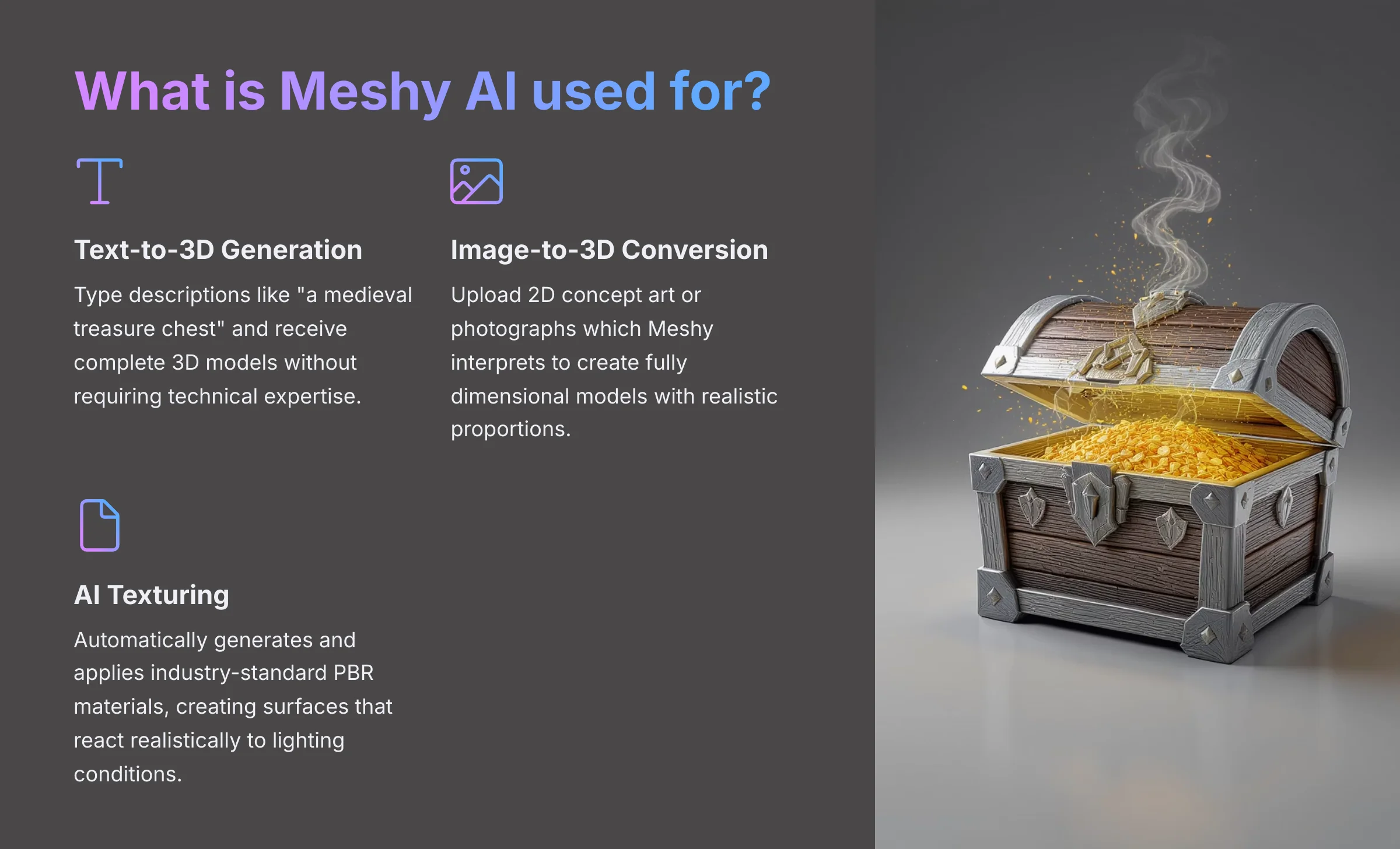

Meshy is an advanced AI-powered platform primarily used for creating high-quality 3D models from text prompts or 2D images. This revolutionary tool serves a diverse range of users, from game developers and product designers to artists, architects, and creative hobbyists, by automating and dramatically simplifying the traditionally complex 3D creation process. Instead of requiring expensive 3D modeling software and years of technical expertise, users can generate professional-quality 3D assets using simple, descriptive language or by uploading reference images. With its intuitive interface and powerful AI algorithms, users can swiftly turn their ideas into tangible 3D objects, making it an essential tool for prototyping and visualization. A recent Meshy Review highlighted its ability to save time and resources while ensuring high fidelity in the models produced. As a result, many creators are embracing this platform as a game-changer in the realm of digital design. With its user-friendly interface, the platform also offers a comprehensive Meshy Tutorial that guides users through the process of creating their first models. This tutorial allows even those with no prior experience to quickly grasp the essentials of 3D modeling. As a result, Meshy empowers a wider audience to turn their creative visions into reality, making it an invaluable tool in various fields. With its intuitive interface and powerful capabilities, Meshy opens up new possibilities for innovation and creativity across various industries. One prominent ‘Meshy Usecase‘ involves designing custom assets for virtual reality experiences, allowing developers to quickly adapt and iterate on their projects. Additionally, artists can use the platform to bring their imaginative concepts to life, creating unique sculptures or environments that were previously limited by technical constraints.
The platform's core functionalities include:
- Text-to-3D generation, where you can type descriptions like “a medieval treasure chest with weathered oak wood and iron reinforcements” and receive a complete 3D model.
- The Image-to-3D feature allows you to upload 2D concept art or photographs, which Meshy then interprets to create fully dimensional models with inferred geometry and realistic proportions.
- Additionally, Meshy's AI Texturing capability automatically generates and applies industry-standard PBR (Physically-Based Rendering) materials, creating surfaces that react realistically to lighting conditions.
These capabilities make Meshy invaluable for rapid prototyping, game asset creation, product visualization, architectural modeling, and bringing creative concepts to life with unprecedented speed and accessibility. The platform bridges the gap between imagination and 3D reality, democratizing 3D content creation for users regardless of their technical background.
Is Meshy AI free to use?
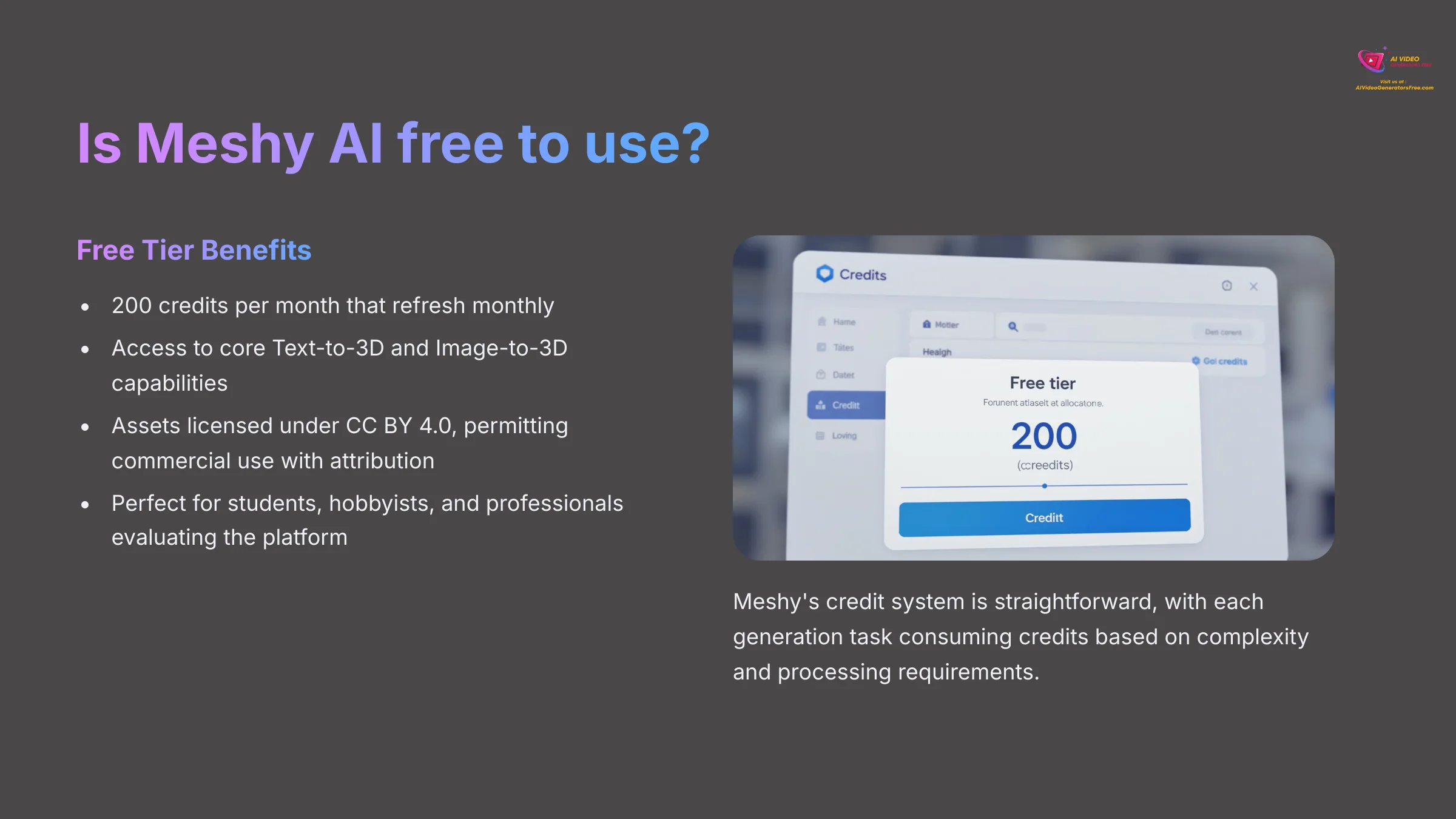

Yes, Meshy offers a generous free tier that allows users to explore and experience the platform's core Text-to-3D and Image-to-3D capabilities without any upfront financial commitment. The Free Plan provides 200 credits per month, which refresh monthly and allow you to generate multiple 3D models to test the platform's quality and workflow for your specific needs.
The credit system is straightforward: each generation task consumes a specific number of credits based on the complexity and processing requirements. This free tier is particularly valuable for students, hobbyists, and professionals who want to evaluate Meshy's capabilities before making a subscription commitment. You can create models, experiment with different prompting techniques, and assess whether the output quality meets your project requirements.
What makes Meshy's free plan especially attractive is that assets created under this tier are licensed under CC BY 4.0, which actually permits commercial use with proper attribution. This is more permissive than many AI platforms that restrict free tier usage to non-commercial purposes only. However, for users requiring higher generation volumes, faster processing speeds, or premium features, paid subscription plans offer significantly more credits and enhanced capabilities.
The existence of this robust free tier eliminates barriers to entry and allows users to gain hands-on experience with AI-powered 3D creation before deciding whether to upgrade to a paid plan for professional or high-volume usage.
How does Meshy work technically?
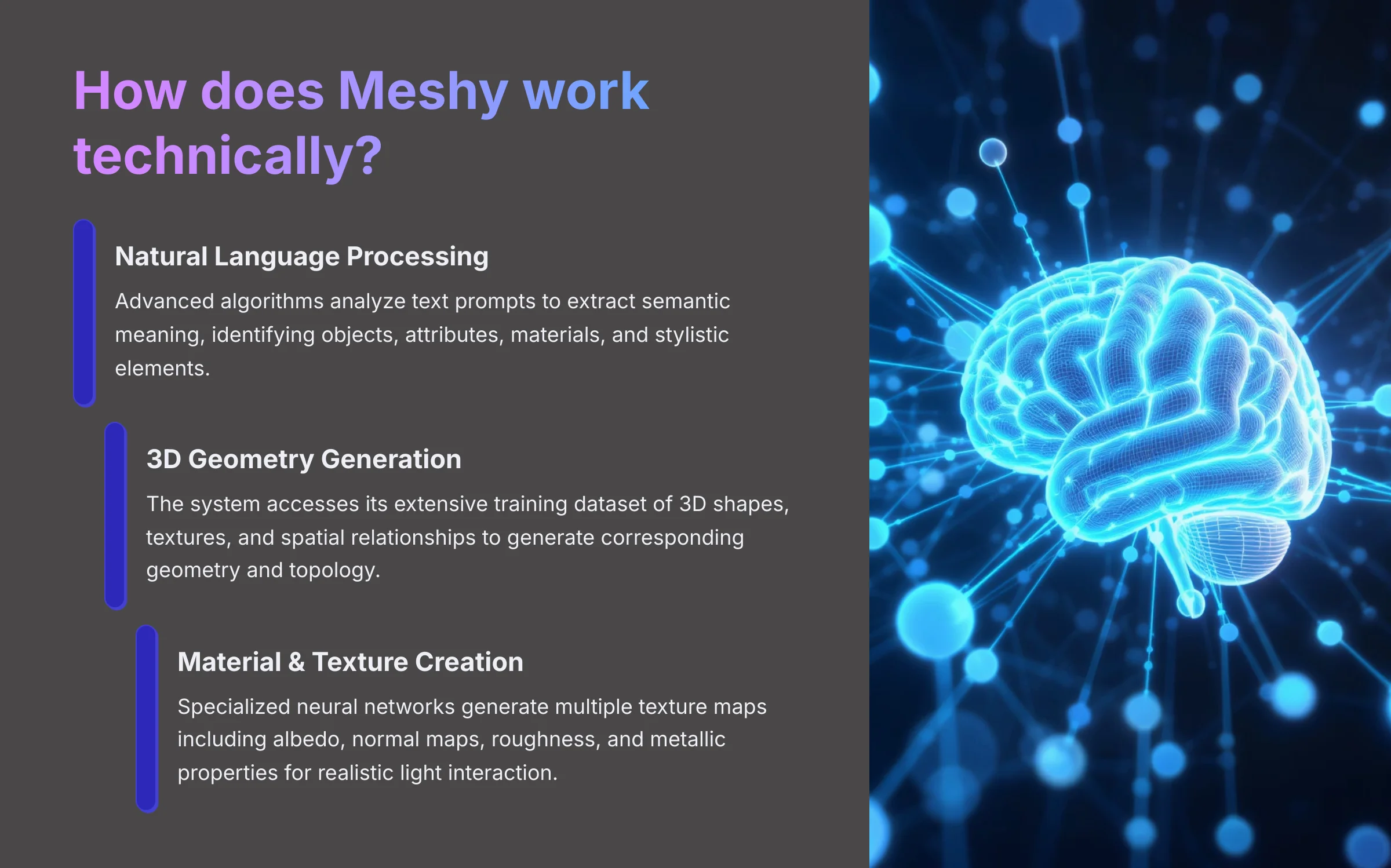

Meshy operates using sophisticated generative AI models specifically trained for 3D geometry creation, similar to how image generation AI works but adapted for three-dimensional space. The underlying technology represents a significant advancement in neural network architecture, combining natural language processing with 3D spatial understanding to transform concepts into tangible digital assets.
When you use the Text-to-3D feature, Meshy's AI performs multiple complex operations simultaneously. First, advanced Natural Language Processing algorithms analyze your text prompt to extract semantic meaning, identifying objects, attributes, materials, and stylistic elements. The system then accesses its extensive training dataset of 3D shapes, textures, and spatial relationships to generate corresponding geometry and topology that matches your description.
For Image-to-3D functionality, the process involves sophisticated computer vision techniques. The AI analyzes input images for depth cues, surface normals, lighting information, and geometric features to infer the three-dimensional structure of objects. It essentially “imagines” the hidden surfaces and internal geometry to construct a complete mesh from partial visual information.
The AI Texturing component utilizes specialized neural networks trained on material properties and surface characteristics. These networks generate multiple texture maps including albedo (color), normal maps (surface detail), roughness, and metallic properties that define how surfaces interact with light. The final output is a production-ready 3D model with industry-standard materials that can be immediately imported into game engines, animation software, or 3D printing workflows.
How do I use Meshy's Text-to-3D feature effectively?
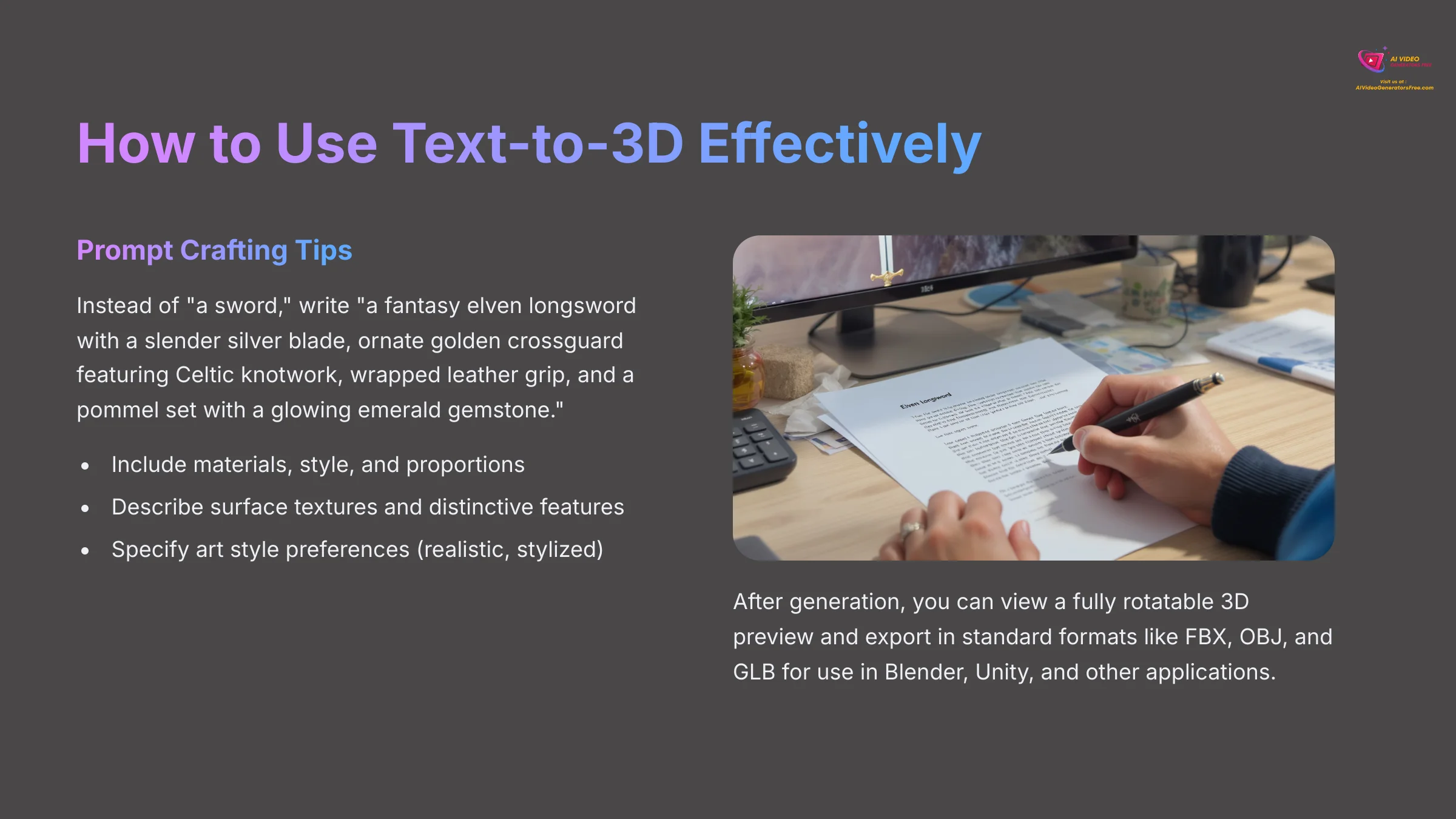

Using Meshy's Text-to-3D feature effectively requires understanding both the technical workflow and the art of prompt crafting. The process begins in your Meshy dashboard, where you'll find an intuitive text input interface designed for users of all experience levels.
The key to exceptional results lies in writing detailed, descriptive prompts that provide the AI with sufficient context and specificity. Here’s a breakdown of the process:
- Craft Detailed Prompts: Instead of generic descriptions like “a sword,” craft comprehensive prompts such as “a fantasy elven longsword with a slender silver blade, ornate golden crossguard featuring Celtic knotwork, wrapped leather grip, and a pommel set with a glowing emerald gemstone.” Include information about materials, style, proportions, surface textures, and any distinctive features that define your vision.
- Select Parameters: After submitting your prompt, you can typically select generation parameters such as art style (realistic, stylized, low-poly), polygon density, and output format preferences.
- Review and Iterate: Once generation completes, you'll see a fully rotatable 3D preview allowing inspection from all angles. If the initial result needs refinement, you can iterate by adjusting your prompt, trying style variations, or using Meshy's additional tools like AI Texturing to enhance surface materials.
- Export for Use: The platform supports standard 3D file formats including FBX, OBJ, and GLB, ensuring compatibility with popular software like Blender, Unity, Unreal Engine, and most 3D printing applications.
Success with Text-to-3D comes from experimentation and learning how the AI interprets different descriptive language patterns.
What are the current limitations of Meshy AI?
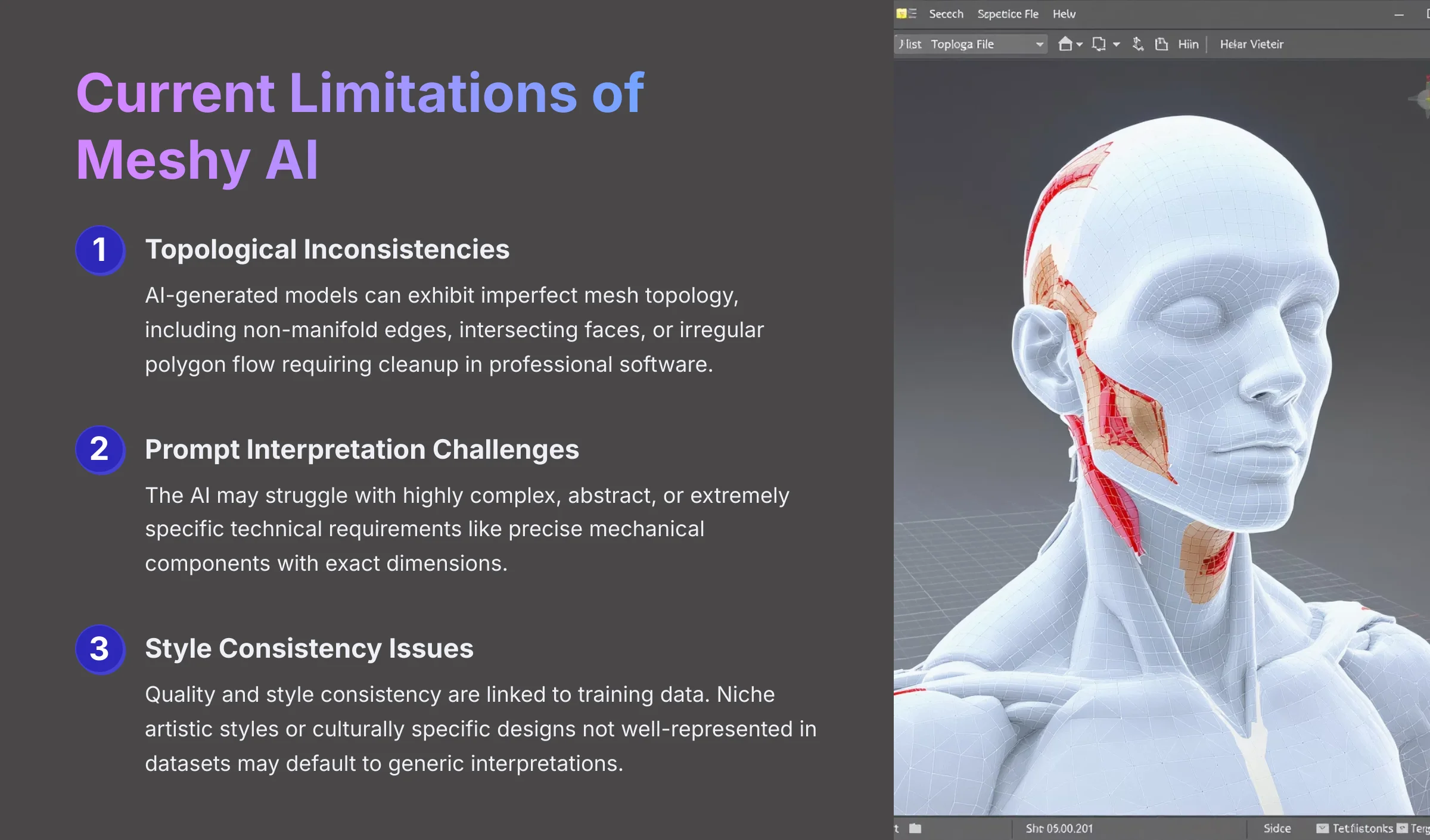

While Meshy represents cutting-edge AI technology, understanding its current limitations helps users set realistic expectations. These limitations are typical of current generative AI technology and continue to improve with each platform update.
- Topological Consistency: AI-generated models can sometimes exhibit imperfect mesh topology, including non-manifold edges or intersecting faces. This “messy” geometry might require cleanup in professional 3D software like Blender or Maya before use in animation pipelines.
- Prompt Interpretation: The AI may struggle with highly complex, abstract, or specific technical requirements. Generating precise mechanical components with exact dimensions or objects with readable text can be challenging.
- Training Data Dependence: The quality and style consistency are linked to the AI's training data. Niche artistic styles or culturally specific designs might not be well-represented, leading to more generic interpretations.
- Complex Assemblies: Multi-part assemblies or models with intricate internal mechanisms may not generate as expected in a single pass.
Understanding these limitations allows you to leverage Meshy's strengths—rapid ideation, asset generation, and creative exploration—while recognizing when traditional 3D modeling remains necessary.
How does Meshy compare to Luma AI and other competitors?
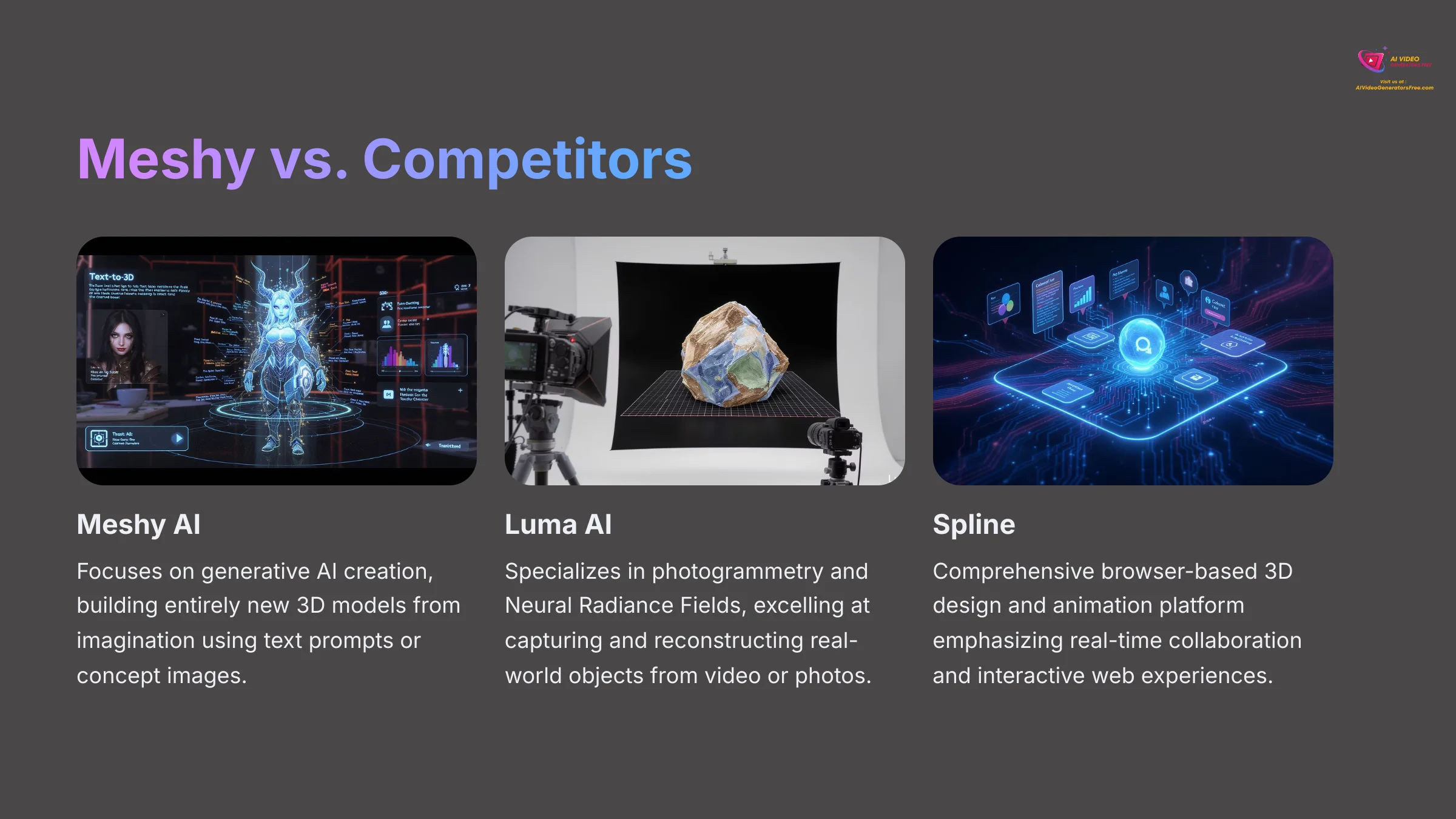

When evaluating AI-powered 3D creation tools, users frequently compare Meshy to competitors like Luma AI and Spline, each offering distinct strengths. Understanding these differences helps you choose the right tool for your specific needs.
| Tool | Core Technology | Primary Use Case |
|---|---|---|
| Meshy AI | Generative AI (Text/Image-to-3D) | Creating original 3D assets from imagination or concept art. Ideal for rapid prototyping and creative exploration. |
| Luma AI | Photogrammetry & NeRFs | Digitizing real-world objects and environments from video or photos with high fidelity. |
| Spline | Browser-based 3D Editor | Creating interactive, web-ready 3D scenes and animations with real-time collaboration. |
These tools often complement each other in modern workflows. You might use Meshy to quickly generate character models, then import those assets into Spline for animation and web deployment, or into Luma AI for integration with photogrammetric environments. Each platform serves specific stages of the 3D content creation pipeline.
What are Meshy's current pricing plans and costs?
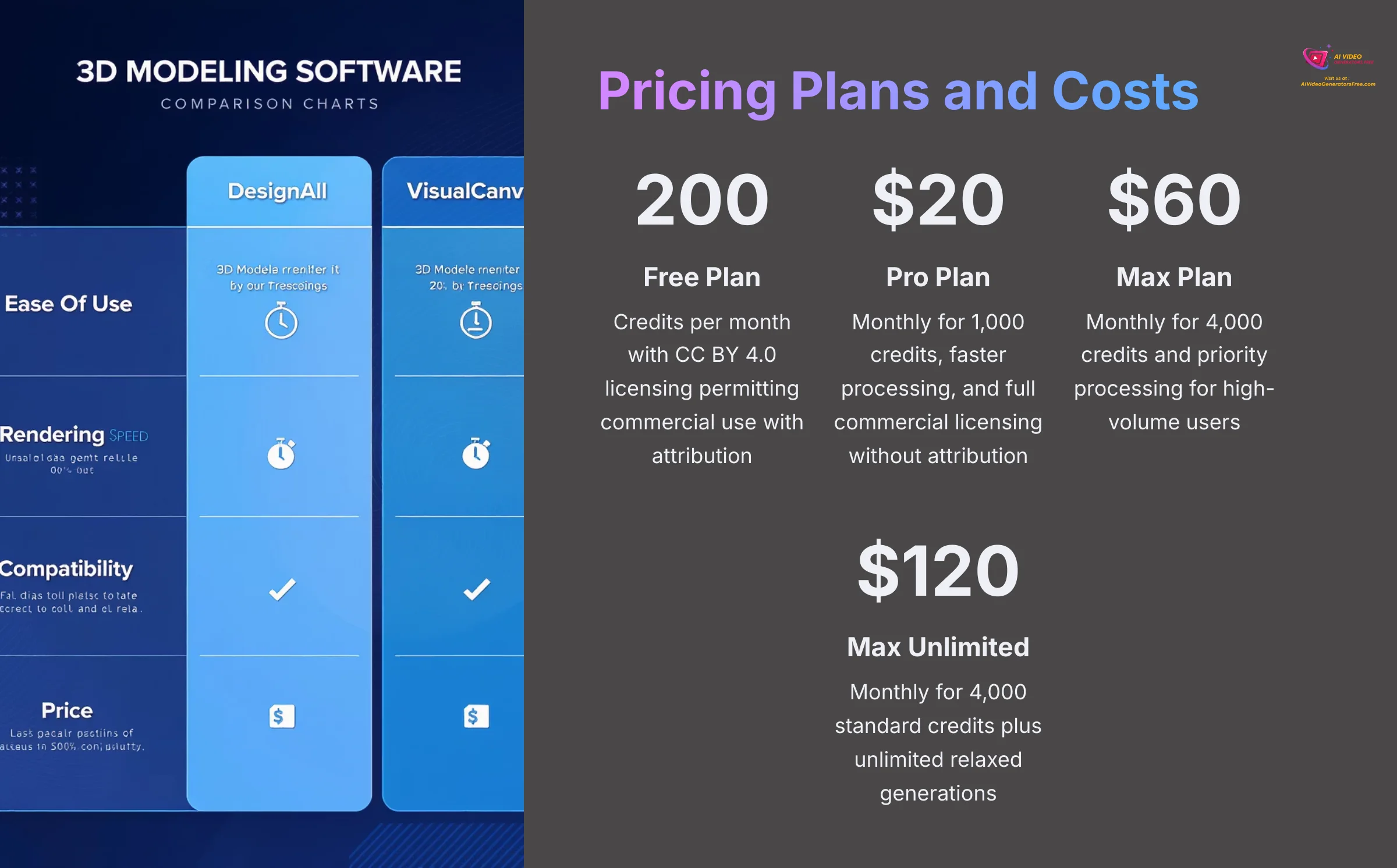

Meshy's pricing is designed to accommodate users from casual experimenters to professional studios. The platform follows a credit-based subscription model for flexibility and scalability.
| Plan | Price (Monthly) | Credits per Month | Key Feature |
|---|---|---|---|
| Free | $0 | 200 | Commercial use allowed with attribution (CC BY 4.0). |
| Pro | $20 | 1,000 | Full commercial licensing without attribution. |
| Max | $60 | 4,000 | Higher credit volume and priority processing. |
| Max Unlimited | $120 | 4,000 + Unlimited Relaxed | Ensures you never run out of generation capacity. |
When selecting a plan, consider your expected monthly generation volume and whether you need commercial licensing. The credit system is transparent, with different generation types consuming varying credit amounts. Professional users requiring commercial rights should opt for paid plans, while the free tier perfectly serves educational and experimental purposes.
Can I use Meshy-created models for commercial projects?
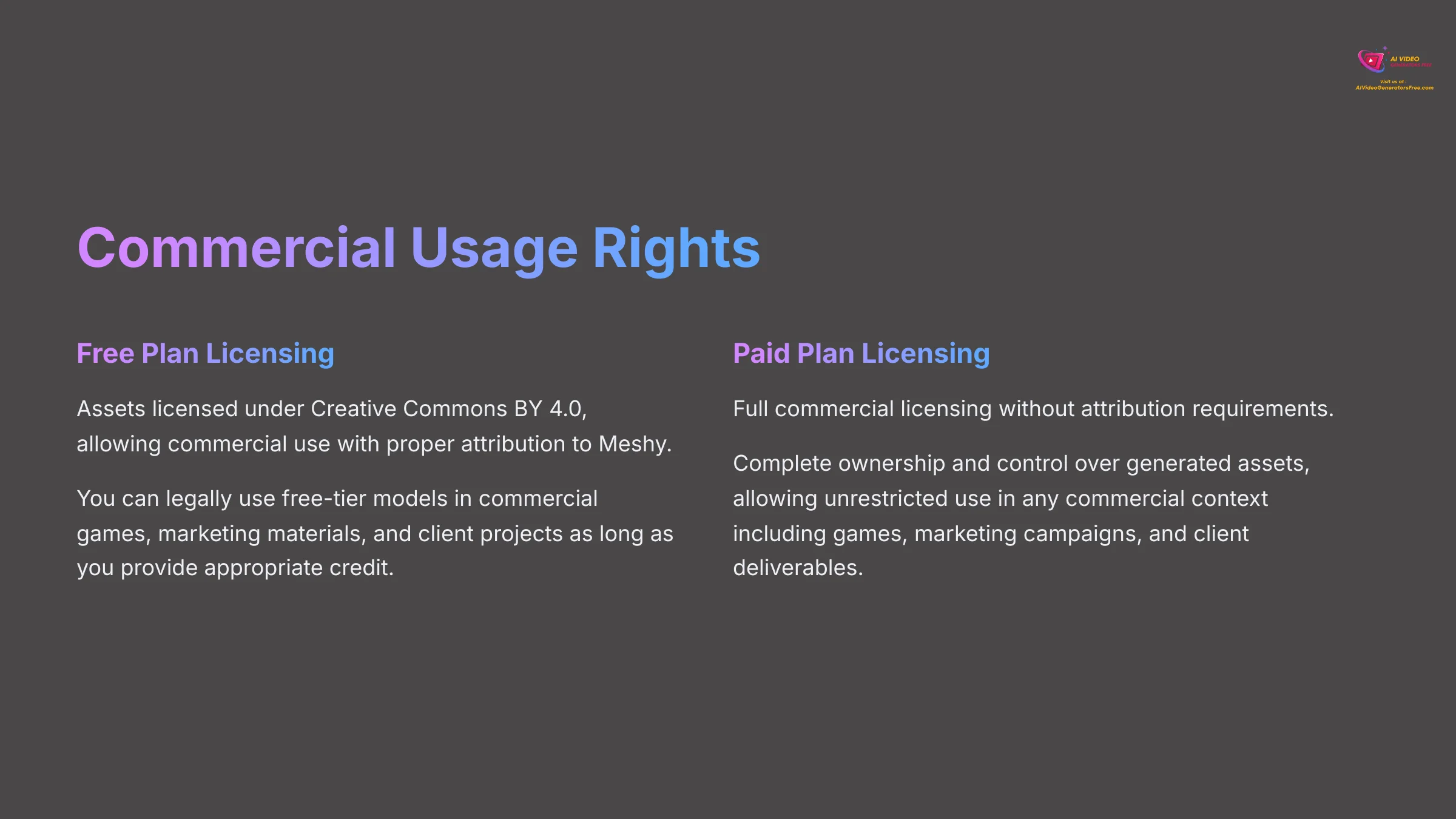

Yes, you can definitely use models created with Meshy for commercial projects, but the licensing terms vary significantly depending on your subscription tier. Understanding these licensing differences is crucial for legal compliance.
Under Meshy's Free Plan, assets are licensed under Creative Commons BY 4.0. This license allows commercial use, modification, and distribution of your generated models, requiring only proper attribution to Meshy. You can legally use free-tier models in commercial games, marketing materials, and client projects as long as you provide appropriate credit. This makes Meshy's free tier more commercially friendly than many competitors.
Upgrading to any paid subscription plan (Pro, Max, or Max Unlimited) grants you full commercial licensing without attribution requirements. This means complete ownership and control over your generated assets, allowing unrestricted use in any commercial context. Paid plans eliminate any attribution obligations and provide the licensing clarity that professional studios and freelancers require.
For businesses and professional creators, paid subscriptions are typically necessary for both the legal framework and the technical capabilities needed for commercial-scale production. Always review the current terms of service when subscribing, as licensing terms can evolve.
Where can I find Meshy tutorials and support resources?
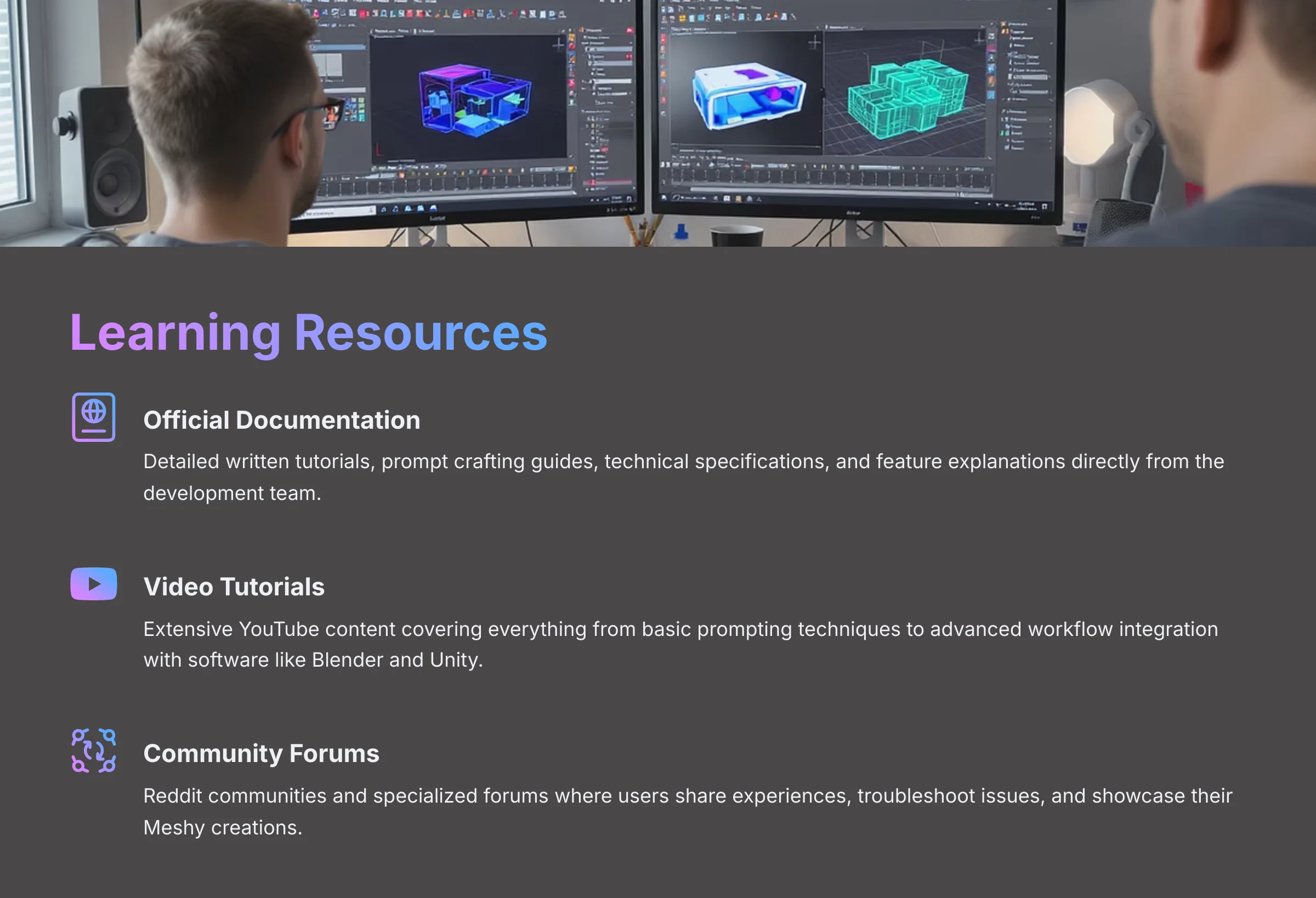

Meshy provides comprehensive learning resources and support channels to help users master the platform. Whether you're a beginner or an advanced user, multiple resources are available:
- Official Documentation: Accessible through their website, this is the most reliable source for written tutorials, prompt guides, and technical specifications.
- YouTube: Searching “Meshy tutorial” yields extensive video content from both Meshy and community creators, covering everything from basic prompting to advanced workflows with software like Blender, Unity, and Unreal Engine.
- Community Forums: Platforms like Reddit (r/3Dmodeling, r/gamedev) offer informal support where users share experiences, troubleshoot issues, and showcase creations.
- Direct Support: Meshy provides customer service through their website contact forms and email. Response times and support quality typically improve with paid subscription tiers.
Staying updated with Meshy's official blog and social media channels also ensures you're aware of new features, updates, and community highlights.

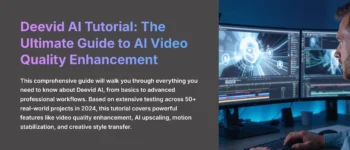
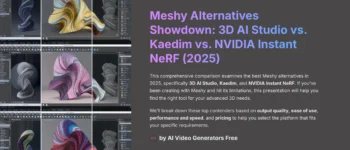
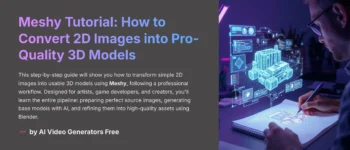





Leave a Reply